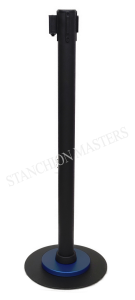 Stanchions: The Unsung Heroes of Crowd Control
Stanchions: The Unsung Heroes of Crowd Control
Stanchions. They’re everywhere, but we hardly ever notice them. These humble posts with their attached ropes or retractable belts are used for crowd control and line management in all sorts of settings, from sporting events to concerts to grocery stores. But despite their ubiquity, no one seems to know what to call them.
Retractable stanchions (as shown to the right) are probably the most common type. They have a built-in belt that can be extended or retracted as needed. This makes them ideal for temporary crowd control situations, such as a concert or a sporting event. Post and rope barriers are another common type. They consist of a post with a rope or chain attached. These barriers are more permanent than retractable stanchions, and they’re often used in areas where crowd control is a more ongoing concern, such as at construction sites or in high-traffic areas.
No matter what type they are, stanchions serve an important function. They help to keep crowds orderly and safe. They can also be used to direct traffic or to create designated areas. And because they’re so versatile, they can be used in a wide variety of settings.
Here are 10 locations where stanchions are commonly used:
- Sporting events: Stanchions are used to create designated areas for spectators, such as sections in a stadium or arena. They can also be used to control access to certain areas, such as the playing field or the concession stands.
- Concerts: Stanchions are used to create a safe and orderly crowd flow at concerts. They can also be used to create designated areas for VIPs or for people with disabilities.
- Grocery stores: Stanchions are used to create orderly lines at checkout counters. They can also be used to create designated areas for produce, meat, or other products.
- Shopping malls: Stanchions are used to create designated areas for stores or for special events. They can also be used to control access to certain areas, such as the food court or the restrooms.
- Construction sites: Stanchions are used to create a safe perimeter around construction sites. They can also be used to direct traffic and to keep pedestrians out of dangerous areas.
- High-traffic areas: Stanchions are used to control pedestrian traffic in high-traffic areas, such as airports, train stations, and subways. They can also be used to create designated areas for waiting or for security screening.
- Schools: Stanchions are used to create designated areas for students, such as lunchrooms and auditoriums. They can also be used to control access to certain areas, such as the library or the gym.
- Hospitals: Stanchions are used to create designated areas in locations such as the cafeteria or patient drop-off and pick up. They can also be used to control access to certain areas, such as the emergency room or the pharmacy.
- Theme parks: Stanchions are used to create designated areas for rides, shows, and attractions. They can also be used to control access to certain areas, such as the water park or the amusement park.
As you can see, stanchions are used in a wide variety of settings. They’re an essential tool for crowd control and line management, and they help to keep people safe in a variety of environments.
So next time you see a stanchion, take a moment to appreciate its unsung heroism. It’s keeping you safe, even if you don’t know it.
Here are some other phrases people use to describe stanchions:
- Line queues
- Safety barriers
- Divider posts
- Retractable belt dividers
- Crowd control barriers
- Rope barriers
- Traffic barriers
- Security barriers
- Access control barriers
As you can see, there are many different ways to refer to stanchions. But no matter what you call them, they’re an essential tool for keeping people safe and orderly.
